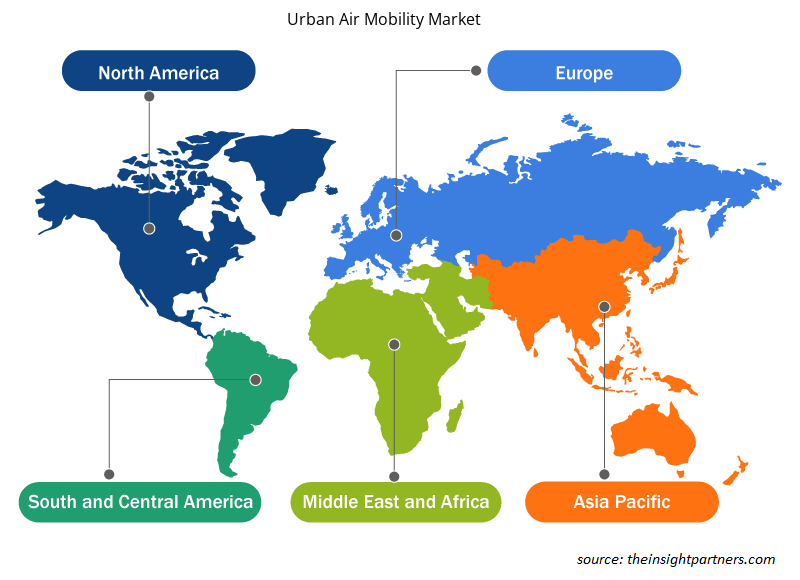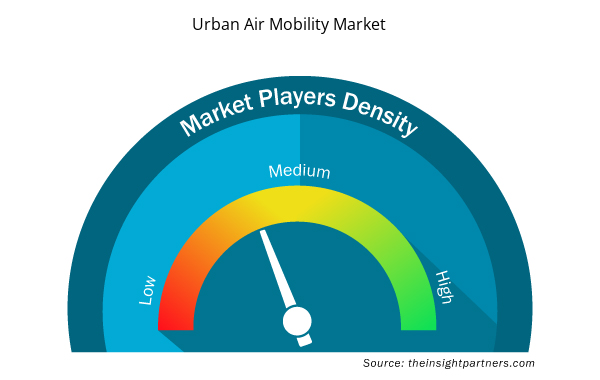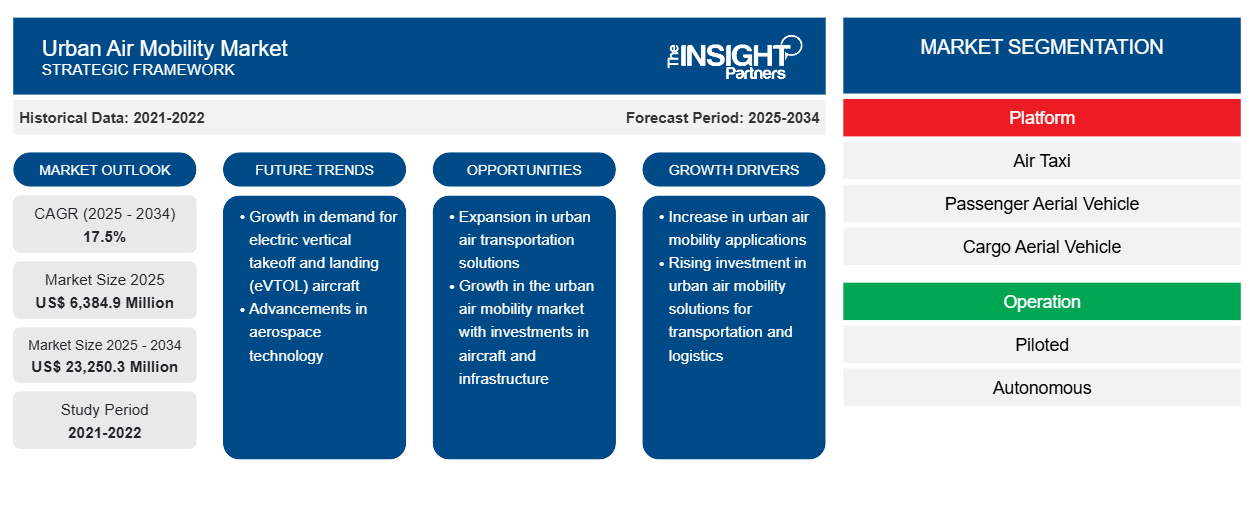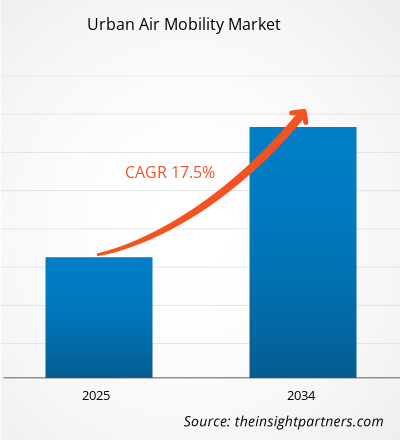预计 2025 年城市空中交通市场价值将达到 63.849 亿美元,到 2034 年将达到 232.503 亿美元。预计在 2025 年至 2034 年的预测期内,城市空中交通市场将以 17.5% 的复合年增长率增长。
城市空中交通客运车可搭载至少三名、最多五六名乘客。在农村地区,根据要求,六名以上的乘客可乘坐三轮客运车出行。城市交通拥堵加剧是推动市场增长的主要因素。随着世界城市人口的增长,交通拥堵严重影响了人们的生活质量,并对整体经济增长造成了影响。例如,根据交通分析公司 INRIX 的数据,美国通勤者在交通高峰期每年大约在交通中花费 41 个小时。它还提到,2017 年交通拥堵给美国司机造成了约 3050 亿美元的损失,平均每位司机损失 1,445 美元。此外,美国环境保护署估计,平均每辆乘用车每年排放 4.7 公吨二氧化碳。此外,随着印度和中国等发展中国家汽车保有量的增加,车祸数量激增。根据世界卫生组织 (WHO) 的数据,每年约有 125 万人死于车祸,每天约有 3,400 人死亡。这还不包括非致命事故造成的数百万人受伤。
全球城市空中交通市场按类型分为客运和货运。根据燃料类型,城市空中交通市场分为柴油、汽油、压缩天然气、液化石油气和电动。对电动城市空中交通的需求不断增加,人口不断增加,以及对有助于缓解交通拥堵的车辆的需求不断增加,这些都推动了全球城市空中交通市场的增长。
定制此报告以满足您的需求
您可以免费定制任何报告,包括本报告的部分内容、国家级分析、Excel 数据包,以及为初创企业和大学提供优惠和折扣
- 获取此报告的关键市场趋势。这个免费样品将包括数据分析,从市场趋势到估计和预测。
城市空中交通市场洞察
航空和自动驾驶技术的进步
航空技术的进步为大都市地区的人员和货物提供便捷、高效的按需运输创造了潜力。城市空中交通 (UAM) 是一种有可能重建社会流动性的交通概念。它提出了高度经济实惠、方便快捷的城市空中交通,通过减轻现有道路交通基础设施的负担,减少地面交通拥堵。UAM 依赖于分布式电力推进等技术的发展、基于应用程序的拼车等新商业模式,以及可降低生产成本的先进航空航天制造趋势。提高车辆自动化和自动驾驶汽车运营的可信度对于实现自主 UAM 愿景至关重要。经济可行的交通系统需要自主性,才能满足预期的高需求。稳定、机动、垂直起降 (VTOL) 车辆和高度自动化飞行的技术成熟度显著提高,将主要推动 UAM 行业的发展。
基于平台的市场洞察
城市空中交通市场根据平台分为空中出租车、客运飞行器、货运飞行器和空中救护车。UAM 有广泛的应用,可以方便快捷地运输货物和人员。这些 UAM 广泛用于运输小件物品、医疗产品,也可以运载乘客。然而,这些交通解决方案有自己的飞行限制,具体取决于它们的用途。UAM 车辆既不能低空飞行,因为它会撞到中型和高层建筑,也不能高空飞行,以免撞到任何航空公司。
基于运营的市场洞察
城市空中交通市场根据运营方式可分为有人驾驶和无人驾驶。预计无人驾驶市场将在预测期内引领市场,因为无人驾驶 eVTOL 更适合货运和客运,预计将越来越多地用于城际交通。
城市空中交通市场的参与者专注于市场计划、收购和产品发布等战略,以保持其在城市空中交通市场中的地位。城市空中交通市场主要参与者的一些发展如下:
2020 年 2 月,空中客车公司与新加坡民航局签署了一份谅解备忘录,以促进新加坡的城市空中交通。此次合作将使该国的城市空中交通更加便利。
2019 年 2 月,Airspace Experience Technologies 与 Spirit AeroSystems 达成最终协议,以打造经过认证的全电动垂直起降 (eVTOL) 飞机。
城市空中交通市场区域洞察
Insight Partners 的分析师已详细解释了预测期内影响城市空中交通市场的区域趋势和因素。本节还讨论了北美、欧洲、亚太地区、中东和非洲以及南美和中美洲的城市空中交通市场细分和地理位置。

- 获取城市空中交通市场的区域特定数据
城市空中交通市场报告范围
| 报告属性 | 细节 |
|---|---|
| 2025 年市场规模 | 63.849 亿美元 |
| 2034 年市场规模 | 232.503 亿美元 |
| 全球复合年增长率(2025 - 2034) | 17.5% |
| 史料 | 2021-2022 |
| 预测期 | 2025-2034 |
| 涵盖的领域 | 按平台
|
| 覆盖地区和国家 | 北美
|
| 市场领导者和主要公司简介 |
|
城市空中交通市场参与者密度:了解其对业务动态的影响
城市空中交通市场正在快速增长,这得益于终端用户需求的不断增长,而这些需求又源于消费者偏好的不断变化、技术进步以及对产品优势的认识不断提高等因素。随着需求的增加,企业正在扩大其产品范围,进行创新以满足消费者的需求,并利用新兴趋势,从而进一步推动市场增长。
市场参与者密度是指在特定市场或行业内运营的企业或公司的分布情况。它表明在给定市场空间中,相对于其规模或总市场价值,有多少竞争对手(市场参与者)存在。
在城市空中交通市场运营的主要公司有:
- 空中客车公司
- 极光飞行科学公司
- 空域体验技术有限公司
- 贝尔德事隆公司
- 亿航智能科技有限公司
免责声明:上面列出的公司没有按照任何特定顺序排列。

- 了解城市空中交通市场主要参与者概况
城市空中交通市场 – 按平台划分
- 空中出租车
- 载人飞行器
- 货运飞行器
- 空中救护车
城市空中交通市场 – 按运营方式
- 试航
- 自主
城市空中交通市场 – 按地区划分
北美
- 我们
- 加拿大
欧洲
- 法国
- 德国
- 英国
- 俄罗斯
- 欧洲其他地区
世界其他地区
城市空中交通市场 – 公司简介
- 空中客车公司
- 极光飞行科学公司
- 贝尔直升机德事隆公司
- 亿航
- 巴西航空工业公司X
- 霍尼韦尔国际公司
- 小鹰
- 穆格公司
- Volocopter 公司
- 历史分析(2 年)、基准年、预测(7 年)及复合年增长率
- PEST 和 SWOT 分析
- 市场规模价值/数量 - 全球、区域、国家
- 行业和竞争格局
- Excel 数据集



Report Coverage
Revenue forecast, Company Analysis, Industry landscape, Growth factors, and Trends

Segment Covered
This text is related
to segments covered.

Regional Scope
North America, Europe, Asia Pacific, Middle East & Africa, South & Central America

Country Scope
This text is related
to country scope.
常见问题
Air Taxi segment led the urban air mobility market. The air taxi usage case is a door-to-door (or near-ubiquitous) ridesharing operation, which permits customers to call vertical takeoff and landing aircraft (VTOLs) to their preferred pickup locations and stipulate drop-off destinations at rooftops across the given city. These rides are on-demand and unscheduled, just like ridesharing applications the customers use in the present scenario. Similar to the air metro case, the aerial vehicles are both autonomous as well as operated by the pilots and can accommodate 2 to 5 passengers simultaneously, by an average load of 1 passenger per trip.
Advances in aviation technologies are creating the potential to provide convenient and efficient on-demand transportation for people and cargo in metropolitan areas. Urban Air Mobility (UAM) is a transportation concept that has the potential to reconstruct societal mobility. It proposes highly affordable, accessible, and fast urban air transit, which would reduce ground-based congestion by off-loading the existing roadways transportation infrastructure. Therefore, the technological advancements in the aviation industry and increasing traffic congestion are the major factors driving the growth of urban air mobility market.
The North America region will lead the Urban air mobility market in 2025 owing to the supportive government initiatives and an increasing number of companies spending rigorously on the development of urban air mobility products.
Trends and growth analysis reports related to Aerospace and Defense : READ MORE..
The List of Companies - Urban Air Mobility (UAM) Market
- Airbus SAS
- Aurora Flight Sciences
- Airspace Experience Technologies, Inc.
- Bell Textron Inc
- EHang Intelligent Technology Co. Ltd
- EmbraerX
- Jaunt Air Mobility LLC
- Kitty Hawk
- Moog Inc.
- Volocopter GmbH
The Insight Partners performs research in 4 major stages: Data Collection & Secondary Research, Primary Research, Data Analysis and Data Triangulation & Final Review.
- Data Collection and Secondary Research:
As a market research and consulting firm operating from a decade, we have published and advised several client across the globe. First step for any study will start with an assessment of currently available data and insights from existing reports. Further, historical and current market information is collected from Investor Presentations, Annual Reports, SEC Filings, etc., and other information related to company’s performance and market positioning are gathered from Paid Databases (Factiva, Hoovers, and Reuters) and various other publications available in public domain.
Several associations trade associates, technical forums, institutes, societies and organization are accessed to gain technical as well as market related insights through their publications such as research papers, blogs and press releases related to the studies are referred to get cues about the market. Further, white papers, journals, magazines, and other news articles published in last 3 years are scrutinized and analyzed to understand the current market trends.
- Primary Research:
The primarily interview analysis comprise of data obtained from industry participants interview and answers to survey questions gathered by in-house primary team.
For primary research, interviews are conducted with industry experts/CEOs/Marketing Managers/VPs/Subject Matter Experts from both demand and supply side to get a 360-degree view of the market. The primary team conducts several interviews based on the complexity of the markets to understand the various market trends and dynamics which makes research more credible and precise.
A typical research interview fulfils the following functions:
- Provides first-hand information on the market size, market trends, growth trends, competitive landscape, and outlook
- Validates and strengthens in-house secondary research findings
- Develops the analysis team’s expertise and market understanding
Primary research involves email interactions and telephone interviews for each market, category, segment, and sub-segment across geographies. The participants who typically take part in such a process include, but are not limited to:
- Industry participants: VPs, business development managers, market intelligence managers and national sales managers
- Outside experts: Valuation experts, research analysts and key opinion leaders specializing in the electronics and semiconductor industry.
Below is the breakup of our primary respondents by company, designation, and region:

Once we receive the confirmation from primary research sources or primary respondents, we finalize the base year market estimation and forecast the data as per the macroeconomic and microeconomic factors assessed during data collection.
- Data Analysis:
Once data is validated through both secondary as well as primary respondents, we finalize the market estimations by hypothesis formulation and factor analysis at regional and country level.
- Macro-Economic Factor Analysis:
We analyse macroeconomic indicators such the gross domestic product (GDP), increase in the demand for goods and services across industries, technological advancement, regional economic growth, governmental policies, the influence of COVID-19, PEST analysis, and other aspects. This analysis aids in setting benchmarks for various nations/regions and approximating market splits. Additionally, the general trend of the aforementioned components aid in determining the market's development possibilities.
- Country Level Data:
Various factors that are especially aligned to the country are taken into account to determine the market size for a certain area and country, including the presence of vendors, such as headquarters and offices, the country's GDP, demand patterns, and industry growth. To comprehend the market dynamics for the nation, a number of growth variables, inhibitors, application areas, and current market trends are researched. The aforementioned elements aid in determining the country's overall market's growth potential.
- Company Profile:
The “Table of Contents” is formulated by listing and analyzing more than 25 - 30 companies operating in the market ecosystem across geographies. However, we profile only 10 companies as a standard practice in our syndicate reports. These 10 companies comprise leading, emerging, and regional players. Nonetheless, our analysis is not restricted to the 10 listed companies, we also analyze other companies present in the market to develop a holistic view and understand the prevailing trends. The “Company Profiles” section in the report covers key facts, business description, products & services, financial information, SWOT analysis, and key developments. The financial information presented is extracted from the annual reports and official documents of the publicly listed companies. Upon collecting the information for the sections of respective companies, we verify them via various primary sources and then compile the data in respective company profiles. The company level information helps us in deriving the base number as well as in forecasting the market size.
- Developing Base Number:
Aggregation of sales statistics (2020-2022) and macro-economic factor, and other secondary and primary research insights are utilized to arrive at base number and related market shares for 2022. The data gaps are identified in this step and relevant market data is analyzed, collected from paid primary interviews or databases. On finalizing the base year market size, forecasts are developed on the basis of macro-economic, industry and market growth factors and company level analysis.
- Data Triangulation and Final Review:
The market findings and base year market size calculations are validated from supply as well as demand side. Demand side validations are based on macro-economic factor analysis and benchmarks for respective regions and countries. In case of supply side validations, revenues of major companies are estimated (in case not available) based on industry benchmark, approximate number of employees, product portfolio, and primary interviews revenues are gathered. Further revenue from target product/service segment is assessed to avoid overshooting of market statistics. In case of heavy deviations between supply and demand side values, all thes steps are repeated to achieve synchronization.
We follow an iterative model, wherein we share our research findings with Subject Matter Experts (SME’s) and Key Opinion Leaders (KOLs) until consensus view of the market is not formulated – this model negates any drastic deviation in the opinions of experts. Only validated and universally acceptable research findings are quoted in our reports.
We have important check points that we use to validate our research findings – which we call – data triangulation, where we validate the information, we generate from secondary sources with primary interviews and then we re-validate with our internal data bases and Subject matter experts. This comprehensive model enables us to deliver high quality, reliable data in shortest possible time.


 获取此报告的免费样本
获取此报告的免费样本